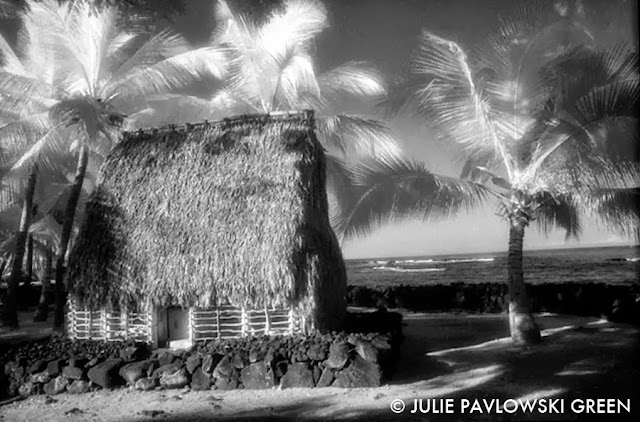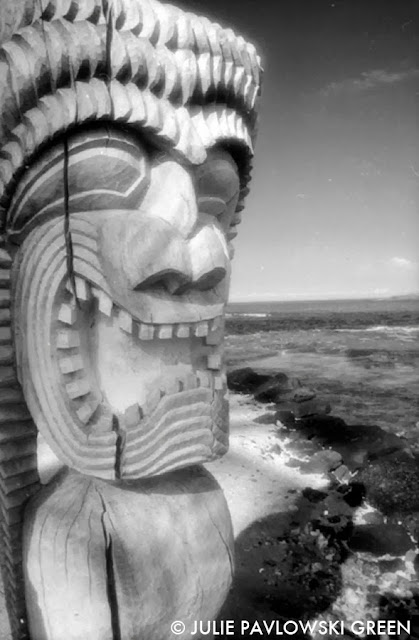Pu'uhonua O Hõnaunau
In honor of our National Park System, which is currently closed due to the shenanigans being played out in Washington D.C., I thought I would feature one of my favorites, Pu'uhonua O Hõnaunau National Historical Park on the Big Island of Hawaii. This National Park is the largest historical park in the state of Hawaii. It is located on the West Coast of the island of Hawaii, South of Kealakekua Bay in southern Kona.
This 180 acre archaeological site, which contained Royal Grounds (Ali'i Lani), a Temple (Heiau) and a place of refuge (Pu'uhonua), had been reconstructed around the ruins of the Hale O Keawe Heiau. Established in 1955, the park was originally called The City of Refuge National Historical Park but was renamed in 2000 to observe the Hawaiian spelling under the Hawaiian National Park Language Correction Act.
Photographing in infrared film, I tried to capture the sacred qualities of the space by using the "Wood Effect" (named after the inventor of infrared film Robert W. Wood), which I feel gives these images a lurid quality.
Temples:
According to Hawaiian Encyclopedia.com, "Heiau's were places where offerings and prayers were made to ‘aumākua, personal or family gods, and sacred guardians and protectors that should be respected and even fed. Some heiau included an ‘anu‘u, or oracle tower, which might be covered with white kapa (tapa) barkcloth. According to tradition, sometime before the year A.D.1200, a Tahitian priest (kahuna) by the name of Pā‘ao founded a high priest line, known as kahuna nui. Pā‘ao returned to Tahiti and brought back a chief named Pili [Kaaiea], who ruled the island of Hawai‘i and sired the royal line leading to King Kamehameha I, beginning a 700-year dynasty. There was a system of laws (kānāwai) that determined if something was kapu (sacred or forbidden). Commoners fell prostrate to the ground in the presence of chiefs, who possessed more mana (divine power)."
According to Hawaiian Encyclopedia.com, "Heiau's were places where offerings and prayers were made to ‘aumākua, personal or family gods, and sacred guardians and protectors that should be respected and even fed. Some heiau included an ‘anu‘u, or oracle tower, which might be covered with white kapa (tapa) barkcloth. According to tradition, sometime before the year A.D.1200, a Tahitian priest (kahuna) by the name of Pā‘ao founded a high priest line, known as kahuna nui. Pā‘ao returned to Tahiti and brought back a chief named Pili [Kaaiea], who ruled the island of Hawai‘i and sired the royal line leading to King Kamehameha I, beginning a 700-year dynasty. There was a system of laws (kānāwai) that determined if something was kapu (sacred or forbidden). Commoners fell prostrate to the ground in the presence of chiefs, who possessed more mana (divine power)."
At the Hale O Keawe Heiau, built by a Kona chief named Kanuha, bones of an important 16th century Kona
chief named Keawe was interred. Wooden carved icons of gods ( Ki'i) guarded the Hale o Keawe Heiau. Today, reproductions were made based on drawings and writing of the 19th century missionary, William Ellias.
The nobility (Ali'i) of Kona continued to be buried here until the abolition of the kapu (Taboo) system by King Kamehameha in 1819.
The nobility (Ali'i) of Kona continued to be buried here until the abolition of the kapu (Taboo) system by King Kamehameha in 1819.
Like the Heiau's, Royal huts were built upon lava-stone platforms but
were a single room and limited by the height of the trees, as they did not have
mortar or nails. The Royal fishponds (Helepalala), near the Royal canoe landing (Keeoneele), were forbidden places punishable by death if one happened to find themselves in the wrong place.
The Keoua Stone, a large rough-hewn slab of rock, was the favorite bench for Chief Keoua. At the sides of the Keoua Stone are six holes such as this one carved into the lava rock, probably to hold poles to elevate a canopy to keep the Hawaiian sun off the king.
The Keoua Stone, a large rough-hewn slab of rock, was the favorite bench for Chief Keoua. At the sides of the Keoua Stone are six holes such as this one carved into the lava rock, probably to hold poles to elevate a canopy to keep the Hawaiian sun off the king.
The Royalty often played a
checker-like game called Konane. Pebbles are placed on a stone (papamu). The last one to be able to move wins. This game sometimes helped to decide a dispute between rival Kings,
rather than going to war. King Kamehameha
I was said to be unbeatable at this game.
A place of refuge (Pu'uhonua) for Hawaiian lawbreakers gave them the opportunity to escape death by reaching the compound. A ceremony of absolution would then allow them to reenter society. That is if they were able to reach it!
A Great Wall was erected around its perimeter, 10 ft high and 17 feet thick made from Pahoehoe lava. It was built in an L shape that separated the royal village from the sanctuary. No blood could be shed behind these walls.
Kapu (Taboo) or sacred laws were punishable by
death unless you could swim to the refuge.
Eating with women, fishing out of season or walking in the Kings shadow are just a couple of examples that would be considered Taboo.
Luckily for us, we can now enjoy the beauty of this sacred space without the fear of being killed for looking in the wrong direction.
Luckily for us, we can now enjoy the beauty of this sacred space without the fear of being killed for looking in the wrong direction.
A hui hou kakou,
Julie Pavlowski Green
Saturday, October 5, 2013





Comments
Post a Comment